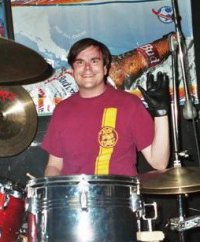Even as it approaches fifty years in business, King Crimson remains an ever-shifting organism. Its shiftiness has been proven by history to be more asset than weakness, and fans have come to accept that sometimes, they may have to get too weird, get too commercial or just go away for a while. Their refusal to commit to a singular way of doing things has led to an impressive pile of intense and innovative music, not delivered in a steady stream but in sporadic bursts whenever the circumstances are just right. On Wednesday night at the Greek, the stars aligned and the king poked his head up for a minute as some of the knottiest, most searing rock music ever made came up for its second wind. This Crimson plays music by all of the Crimsons that came before it, but does so in a way that doesn’t sound like any of them. And so the organism takes on a new form, maybe its most crowd-pleasing ever.
The 2017 edition of the band is an eight-piece, with a back-from-hiatus Bill Rieflin relocated from drums to keyboards, a front-line batterin’ trio of Pat Mastelotto, Jeremy Spencer and Gavin Harrison, Mel Collins on winds & reeds, Tony Levin on bass, Jakko Jakszyk on vocal and guitar, and co-founder/ mastermind/ guitarist Robert Fripp. With a membership made up of 50% new blood and 50% returning vets, there is a stated rule that “all material is to be treated as new” and thus subject to revision. Shifts in instrumentation are common – David Cross’ violin parts from the band’s 1973-74 albums are handed off to Collins to play on sax or Rieflin to play on organ. And the tri-drummer lineup has integrated itself seamlessly, a big improvement since their appearance at the Orpheum a few years ago. That show cetainly wasn’t bad, but it lacked snap. They snap now.
One other noticeable change from that 2014 show, they do material from their 80s albums now. But Jakszyk seems to be allergic to Adrian Belew’s Talking-Head vocalizations and ignores most of the words, as in the jazzed-up opener “Neurotica” and a shimmering “The ConstrucKtion of Light”, or sings them with a new melody, as on “Indiscipline.”
Their earliest material is delivered the most faithfully, although from my seat in section A, I could see Fripp sitting out almost the entirety of both “Cirkus” and “In The Court Of The Crimson King”, letting Jakszyk tackle the guitar parts single-handed. The mid-period jams like “Easy Money” and “Larks Tongues In Aspic Part 1” are as elastic and open-ended as they were on album, stretching into new shapes under the influence of new players.
What’s particularly obvious is that this regrouping has energized Fripp. At the end of the previous incarnation’s touring days, he had walled himself off from the audience behind racks of gear, horrified at the prospect of having his picture taken by the audience. Michael McKean’s character on Better Call Saul, with his perceived allergy to electricity, kind of reminded me of Fripp – suffering over something most people don’t even notice but he, for whatever reason, cannot abide. But while they still ask people not to take snaps – and a remarkably high percentage of the audience respects their wishes – he can now face us without fear, playing brilliantly on old music and new.
And while there’s justified excitement over the chance to finally hear songs from the band’s entire history played at one show, they also did three new songs; “Radical Action III” in the first set, “Meltdown” and “Radical Action II” during the second. People of my generation will ask “where’s the new album?” and be told there are no plans for anything so…20th century.
As one contemplates the idea that a veteran band might no longer have albums at all, no totems to define their era, the term “radical action” doesn’t seem so far fetched from a band at the half century mark.



Pingback: Beat Recommends: King Crimson at the Greek | The LA Beat